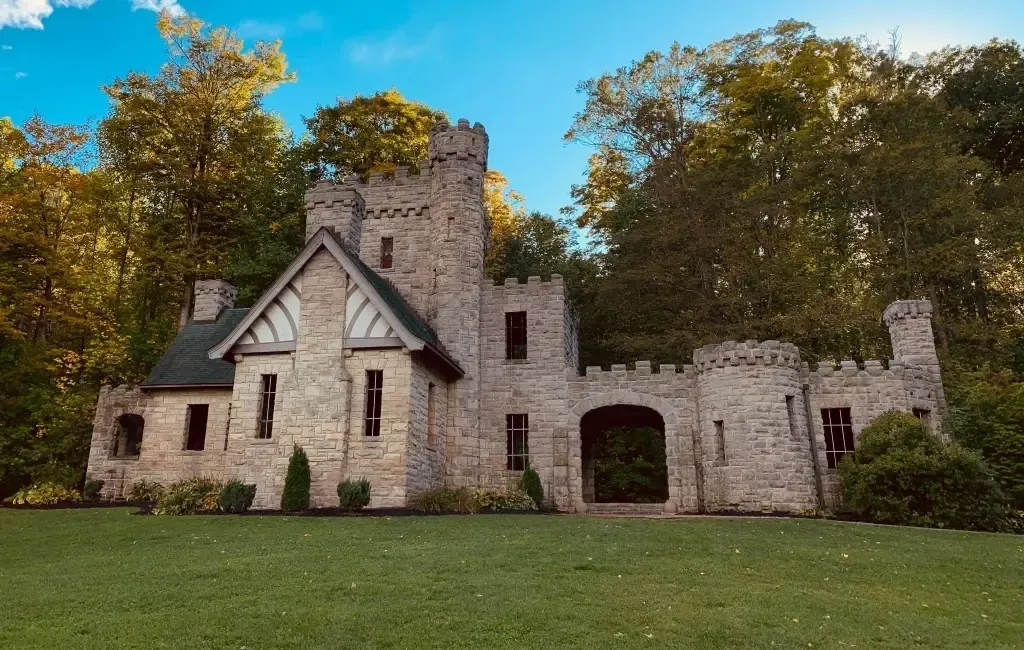Squire’s Castle holds a special place in the Cleveland area, not just for its scenic beauty but also for its role in outdoor recreation and historical intrigue. Despite common misconceptions, it was never the residence of Feargus B. Squire, the man who built it in the 1890s. Instead, it was meant to serve as the gatekeeper’s home for a larger estate project that never came to fruition.

Feargus B. Squire, then vice president and general manager of the Standard Oil Company, had envisioned an expansive residential complex spanning 525 acres for himself and his wife, Rebecca. However, the main estate building was never constructed, leaving Squire’s Castle as the sole completed structure on the property.
Despite rumors of ghostly hauntings, there is no substantial evidence to support such claims. Rebecca Squire, often cited as the supposed ghost of the castle, passed away from a stroke in Wickliffe, Ohio, in 1929, years after the property was sold. Therefore, the notion of her spirit haunting the castle remains unsubstantiated.


Feargus B. Squire, hailing from Exeter, England, settled in Cleveland in 1860 after stints in New York and Baltimore. Joining Standard Oil of Ohio in 1885, he’s credited with pioneering the first oil shipment tank wagon. Squire and his wife initially lived on Prospect Avenue before relocating to Euclid Avenue’s affluent Millionaire’s Row at East 78th Street.
In 1890, Squire acquired 525 acres in the Chagrin Valley, envisioning a grand estate named “River Farm Estate.” He planned two English or German-style baronial halls, with the existing structure, now Squire’s Castle, serving as a gatehouse and caretaker’s quarters. Crafted from local silt stone, the castle boasts picturesque castellated and turreted designs.

Squire’s ambitious plans included tree groves, roads, bridges, and ponds, like Sunset Pond, situated nearly two miles from the castle. However, the estate’s main residence never materialized, largely due to Rebecca Squire’s reluctance to embrace country living.

Instead, Feargus Squire opted to build Cobblestone Garth, a sprawling estate in Wickliffe, Ohio, where he later served as mayor. Despite the grandiose plans for the River Farm Estate, only Squire’s Castle stands as a reminder of the original vision.
In 1922, Feargus Squire sold the Chagrin Valley property to a private developer, eventually becoming part of the North Chagrin Reservation of the Cleveland Metroparks in 1925. It was during this period that locals began dubbing the deserted gatehouse “Squire’s Castle.”
Even after relocating to Wickliffe, Squire frequently retreated to the castle on weekends, often accompanied by his daughter Irma rather than his wife. The castle boasted numerous bedrooms, living spaces, a spacious kitchen, and a breakfast porch, offering ample room for leisure. Squire’s library, positioned at the castle’s western end, featured books, mementos, paintings, and trophy cabinets, along with souvenirs from his hunting expeditions such as stuffed animals, hides, and horns. With white plaster walls and exquisite woodwork, the rooms provided a cozy ambiance, while leaded glass windows offered panoramic views of the surrounding property.

Today, Squire’s Castle remains a striking yet empty structure. Its interior has been stripped bare and exposed to the elements due to vandalism and safety concerns. All doors, flooring, fixtures, window glass, and woodwork have been removed, leaving behind only descriptive plaques on the walls. Iron struts that once supported the upper stories are now visible, along with mounting holes for leaded glass windows on some windows.
Despite its state of disrepair, Squire’s Castle still holds its position on a gentle rise west of Chagrin River Road in Willoughby Hills, Ohio. Its front yard opens onto a vast grassy field, while its rear overlooks a rugged incline with walking paths. Each window offers breathtaking views of the surrounding natural landscape, making it a popular spot for weddings, picnics, hikes, and reunions. Occasionally, the castle’s mysterious atmosphere sparks urban legends, further adding to its appeal as one of northeast Ohio’s most cherished landmarks.



